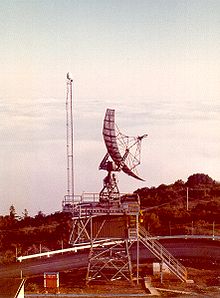
Height finder
Encyclopedia

Early height finder implementations were optical devices and later migrated to radar devices. Devices combining both optics and radar were deployed by the U.S. Military.
Optical
In World War II, a height finder was an optical rangefinderCoincidence rangefinder
A coincidence rangefinder is a type of rangefinder that uses mechanical and optical principles to allow an operator to determine the distance to a visible object....
used to determine the altitude of an aircraft (actually the slant range
Slant range
In radio electronics especially radar terminology, slant range is the line-of-sight distance between two points which are not at the same level relative to a specific datum....
from the emplacement which was combined with the angle of sight, in a mechanical computer, to produce altitude), used to direct anti-aircraft guns. Examples of American and Japanese versions exist, certainly a German and Russian version exist.
Radar
A height finder radarRadar
Radar is an object-detection system which uses radio waves to determine the range, altitude, direction, or speed of objects. It can be used to detect aircraft, ships, spacecraft, guided missiles, motor vehicles, weather formations, and terrain. The radar dish or antenna transmits pulses of radio...
is a type of 2-dimensional radar
Radar
Radar is an object-detection system which uses radio waves to determine the range, altitude, direction, or speed of objects. It can be used to detect aircraft, ships, spacecraft, guided missiles, motor vehicles, weather formations, and terrain. The radar dish or antenna transmits pulses of radio...
that measures altitude
Altitude
Altitude or height is defined based on the context in which it is used . As a general definition, altitude is a distance measurement, usually in the vertical or "up" direction, between a reference datum and a point or object. The reference datum also often varies according to the context...
of a target.
The radar operator slews the antenna toward a desired bearing, identifies a target echo at a desired range on the RHI display (RHI = range height indicator), then bisects the target with a cursor that is scaled to indicate the approximate altitude of the target. Such systems often complement 2-dimensional radars which find distance and direction (search radar); thus using two 2-dimensional systems to obtain a 3-dimensional aerial picture. Height finding radars of the 1960s and 70s were distinguished by their antenna being tall, but narrow. As beam shape is a function of antenna shape, the height finder beam was flat and wide horizontally (ie, not very good at determining bearing to the target), but very thin vertically, allowing accurate measurement of elevation angle, thus altitude.
Modern radar sets have 3-dimensional capability making height finder radars largely obsolete.

